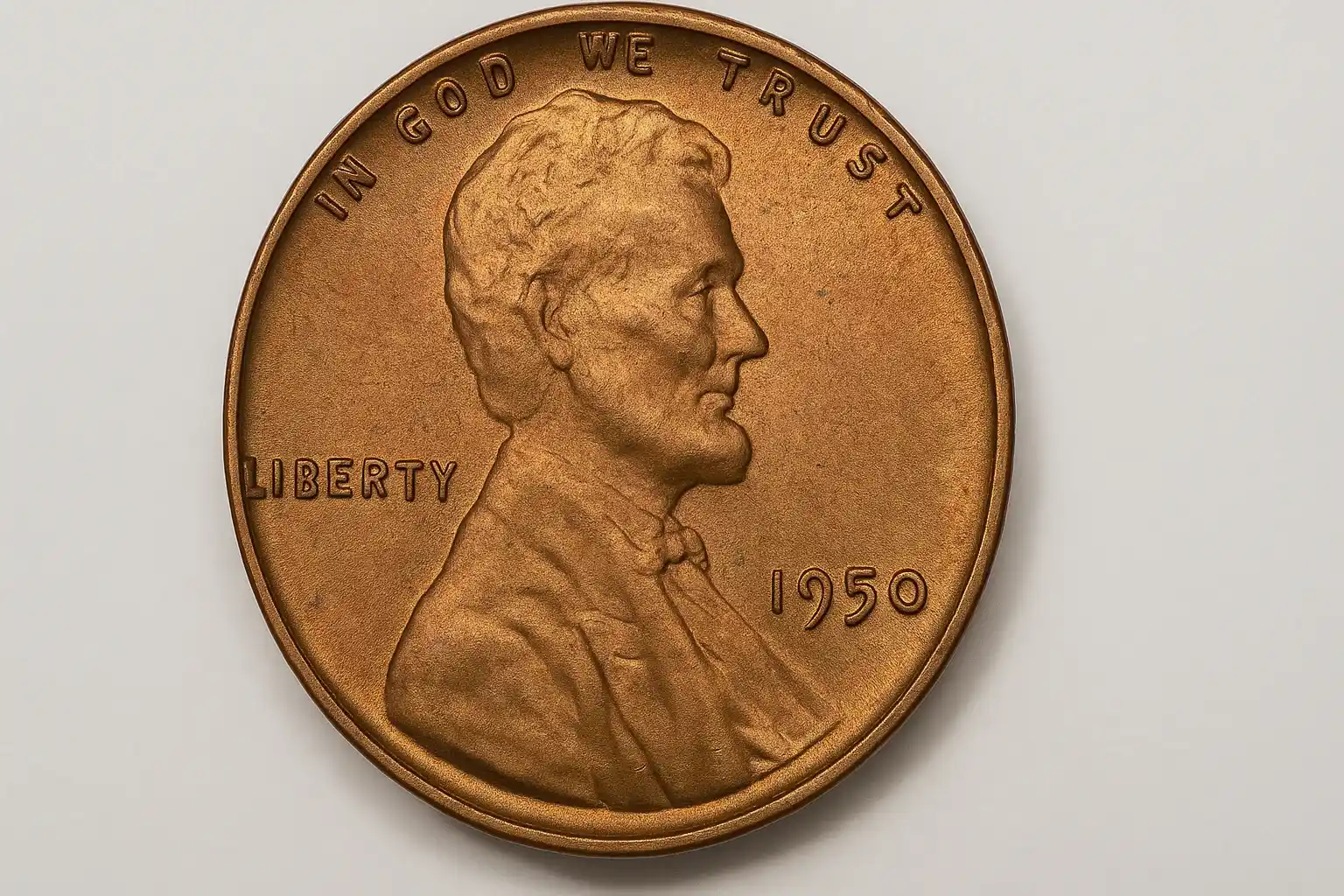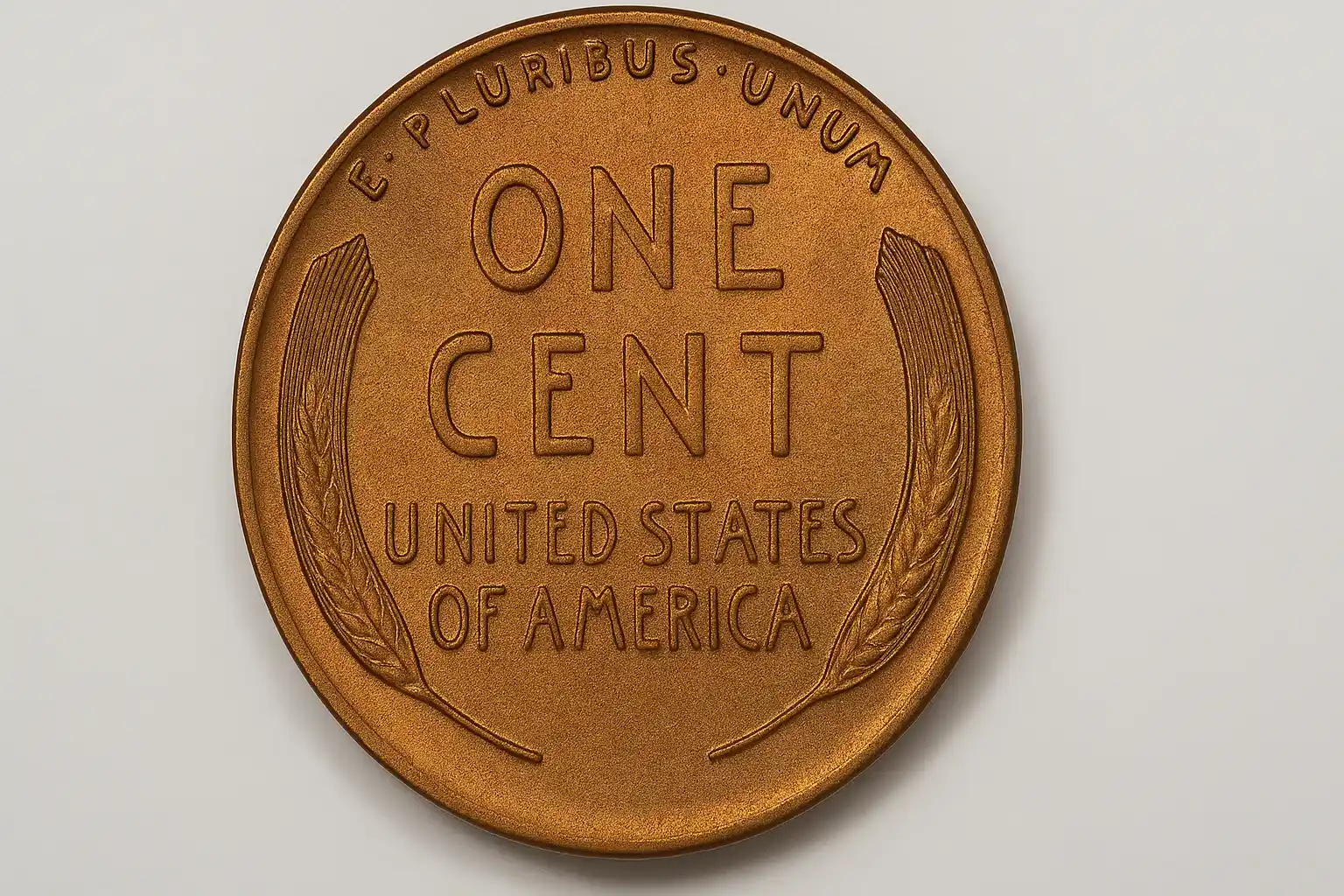The Lincoln Wheat cent, struck from 1909 through 1958, is one of the most collected U.S. coin series. By 1950, production was well established, and billions of cents had entered circulation.
The coin of that year is not rare in absolute numbers, but the 1950 Wheat penny value of each coin depends heavily on grade, strike quality, and color designation (Brown, Red-Brown, or Red). Understanding these factors is essential for accurate appraisal.
Mintage and Composition
Philadelphia (no mintmark): 272,635,000 struck
Denver (D mintmark): 334,950,000 struck
Total mintage exceeded 600 million, ensuring that most 1950 cents survive in circulation. These coins were struck on bronze planchets of 95% copper and 5% tin and zinc, weighing 3.11 grams, with a plain edge and a diameter of 19 millimeters.

Grading
As a grader, I evaluate several key features:
Obverse (Front):
Look for wear on Lincoln’s cheekbone, jawline, and hair above the ear.
The fields (flat areas) should be free of excessive contact marks.
A strong strike shows sharp separation between hair strands and facial details.
Reverse (Back):
Examine the wheat ears. Weak strikes blur the upper lines.
Lettering (“ONE CENT” and “UNITED STATES OF AMERICA”) should remain bold.
Color Designation:
BN (Brown): Fully toned to chocolate brown; least valuable.
RB (Red-Brown): Retains 25–75% mint red luster.
RD (Red): Retains 85% or more original red luster; highest premium.
Value by Grade
Philadelphia Issue (No Mintmark)
Grade | Value |
Good (G-4) | $0.05 |
Fine (F-12) | $0.08 |
Very Fine (VF-20) | $0.10 |
Extremely Fine (XF-40) | $0.15–$0.25 |
About Uncirculated (AU-50) | $0.35–$0.50 |
Mint State (MS-63 BN) | $1.00–$2.00 |
Mint State (MS-65 RB) | $6–$10 |
Mint State (MS-65 RD) | $8–$15 |
Mint State (MS-67 RD) | $200–$300+ |
Denver Issue (D Mintmark)
Grade | Value |
Good (G-4) | $0.05 |
Fine (F-12) | $0.08 |
Very Fine (VF-20) | $0.10 |
Extremely Fine (XF-40) | $0.20–$0.25 |
About Uncirculated (AU-50) | $0.40–$0.75 |
Mint State (MS-63 BN) | $1.00–$1.50 |
Mint State (MS-65 RB) | $5–$9 |
Mint State (MS-65 RD) | $7–$12 |
Mint State (MS-67 RD) | $150–$250+ |
BN / RB / RD Values Comparison
Grade | BN (Brown) Value* | RB (Red-Brown) Value* | RD (Red) Value* |
MS-63 | ~$1 – $3 (typical BN) | ~$5 – $12 | ~$7 – $25 |
MS-64 | ~$2 – $5 | ~$10 – $20 | ~$15 – $40 |
MS-65 | ~$5 – $10 | ~$25 – $50 | ~$50 – $120 |
MS-66 | ~$10 – $25 | ~$70 – $150 | ~$150 – $400+ |
MS-67 | Rare in BN/RB; modest premium | High premium; few examples | $300-$1,000+ |
* Values approximate, USD, for Philadelphia, Denver, or San Francisco mint issues; small-mintmark examples (e.g. “D” or “S”) and coins with superior surfaces may command higher prices. You may check the values in the Coin ID Scanner app.
Varieties and Errors
The 1950 cent has no major listed varieties, but specialists recognize several collectible features:
Repunched Mintmarks (RPMs): Several known RPM varieties exist for the 1950-D. Strong examples can command premiums from $10 to $50 depending on clarity.
BIE Error: A die break between the “B” and “E” in LIBERTY, forming what resembles an “I.” These minor die cracks are inexpensive but collected by Wheat cent fans.
Off-Center Strikes: Coins struck 10–30% off-center with full date visible may bring $25–$75.
Cuds and Die Cracks: Raised areas caused by failing dies, collectible to error specialists.
Auction Highlights
Auction records demonstrate the premium attached to high-grade, full red examples:
1950 (Philadelphia) MS-67 RD, PCGS: Sold for $552 (Heritage Auctions, 2019).
1950-D MS-67 RD, PCGS: Realized $360 (GreatCollections, 2021).
1950 MS-66+ RD, CAC-approved: Brought $204 (Stack’s Bowers, 2020).
These results confirm that condition rarity drives demand, not mintage figures.

Where to Buy and Sell
The 1950 Wheat Penny is common enough that it trades in many places, but the right venue depends on what you have and what you want.
If your coin is a circulated example worth only a few cents, the simplest option is a local coin shop or even rolling it with other cents for the bank. These won’t carry a premium, so convenience is the priority.
For uncirculated pieces or coins with attractive Red or Red-Brown color, coin shops and shows are good because you can deal directly with specialists who know the Lincoln cent market. Dealers will usually offer less than retail, since they need room for resale, but you get immediate payment.
If your coin is certified by PCGS or NGC and grades MS-65 or higher, particularly in Red designation, auctions are the best venue. Major houses such as Heritage or Stack’s Bowers consistently attract collectors looking for condition rarities, which drives competition and higher prices. Online marketplaces like eBay or GreatCollections also work, provided you use clear photos and accurate descriptions.
Buying follows the same pattern. Circulated examples can be picked up at shops or even in bulk from online sellers. High-grade or certified coins are better sourced from auction houses and established dealers, where authenticity and grade are guaranteed.
It’s important to match the selling or buying venue to the quality of the coin. Everyday 1950 cents belong in everyday channels; high-end Mint State pieces deserve professional handling to realize their full value.
Market Outlook
The 1950 Wheat cent is readily available in circulated grades, but upper-end certified examples remain scarce.
For beginners: Circulated 1950 cents are inexpensive entry pieces, often sold in bulk.
For intermediate collectors: MS-64 to MS-65 RB coins are affordable and attractive for a complete set.
For advanced collectors: MS-67 RD coins are condition rarities and represent the pinnacle of the issue.
Projection
Best-case scenario: Certified MS-67 RD coins should continue to maintain strong premiums, as populations remain limited.
Worst-case scenario: Circulated examples will always remain tied to face value with minimal premiums.
Conclusion
The 1950 Wheat Penny is a common issue with exceptional potential in top grades. While it does not rival the famous key dates such as the 1909-S VDB or 1914-D, it offers collectors an affordable addition to their set and advanced numismatists a rewarding hunt for gem-quality red examples. Value depends not on mintage but on grade, color designation, and eye appeal—the essential criteria in professional grading.
FAQs
Is the 1950 Wheat Penny rare?
No. Over 600 million were minted between Philadelphia and Denver. Circulated examples are common, but high-grade Red Mint State coins are much scarcer and carry strong premiums.
How much is a 1950 Wheat Penny worth?
Circulated pieces are usually worth only a few cents. In Mint State with full Red color, values can range from $10 to several hundred dollars depending on grade and certification.
Which mint is more valuable, 1950 or 1950-D?
Both had large mintages, but high-grade 1950-D coins in full Red often bring slightly stronger prices due to fewer pristine survivors.
What is the most valuable 1950 Wheat Penny?
A certified MS-67 RD example, especially from PCGS or NGC, can sell for several hundred dollars at auction. Condition rarity, not mintage, is what drives value.
Are there any errors for this year?
Yes. Collectors search for repunched mintmarks (RPMs), BIE die cracks in LIBERTY, and off-center strikes. These are minor varieties but can add premiums.
How do I know if my 1950 Wheat Penny is Red, Red-Brown, or Brown?
A Red coin retains 85% or more original mint color. Red-Brown shows partial red with noticeable toning. Brown coins are fully toned with little or no mint red remaining.
Where should I sell a valuable 1950 Wheat Penny?
Certified high-grade pieces do best at auctions or through established dealers. Lower-value examples are fine for shops, shows, or online marketplaces.
Should I clean my 1950 Wheat Penny before selling?
No. Cleaning lowers value and can make a coin unsellable to serious collectors. Always keep coins in their natural state.